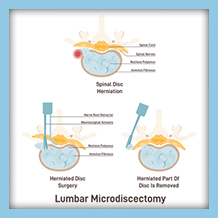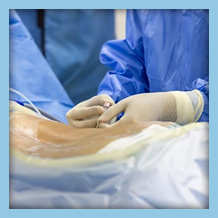

Having a lumbar microdiscectomy done can provide relief, but it does include specific risks that should be considered by your medical team. However, many people have it done every year without problems. Here is what you need to know about a lumbar microdiscectomy.
What is a Lumbar Microdiscectomy?
A lumbar microdiscectomy is a way to surgically remove herniated disc material that puts pressure on the nerves of your legs. A herniated disc is out of alignment, which means it can put pressure directly on the spinal cord. Rather than correcting the alignment of the entire disc, the surgeon removes the section of the disc that is pushing on the spinal cord. This relieves the pressure and reduces the risk of damaging the cord.
Why You May Need a Lumbar Microdiscectomy
Herniated discs can be difficult to fix. The process is extensive and requires the detachment of the disc so it can be reattached properly. This is risky and can lead to serious problems if something goes wrong.
To minimize the risk to the patient, a doctor may recommend a lumbar microdiscectomy instead. Removing the small portion of the disc leaves the rest of it intact. That way, there is no risk of damaging the spinal cord, and the rest of the spine stays stable.
In some cases, it may not be possible to correct a herniated disc. A patient may not be able to handle the procedure, or the disc may not hold up if it is worked on. If correcting the disc is not possible, then removing the problem section is the next best option.
Who Qualifies for a Lumbar Microdiscectomy?
The right person for a lumbar microdiscectomy is someone who has tried other treatments for a herniated disc with no relief. It may be that other treatments do not work, or they can only reduce the pain a certain amount. Patients who have a disc herniation or disc degeneration that is pressing on a nerve root may be candidates for a microdiscectomy.
Benefits of a Lumbar Microdiscectomy
A lumbar microdiscectomy is a commonly performed surgery for a herniated disc in the lumbar (lower) spine. After the procedure, patients often have reduced pain. They also usually have less leg weakness, numbness, and other problems related to the herniated disc.
Some patients have to have a lumbar microdiscectomy because they have a large herniation that cannot be treated with another procedure. Other patients have recurrent disc herniations. In these cases, a lumbar microdiscectomy can help prevent new problems from recurring.
A lumbar microdiscectomy can provide pain relief and allow you to return to your normal activities sooner than other treatments for a herniated disc.
Recovery Steps After a Lumbar Microdiscectomy
After a lumbar microdiscectomy, you will need to rest and recover. Your doctor will give you specific instructions, but in general, you should:
- Use crutches or a walker to help with leg weakness after surgery.
- Stay in bed or in a reclining chair while you recover.
- Use ice packs to help reduce swelling.
- Take prescribed pain medication.
- Take antibiotics before surgery to prevent infection.
- Ask your doctor when you can start moving and resume daily activities again.
- Schedule a follow-up appointment with your doctor after surgery.
You will have an incision where the scalpel was used to remove disc material. The incision will be on your lower back and will be stitched up. Your lumbar microdiscectomy doctor may prescribe a course of antibiotics to prevent infection.
After the surgery, bed rest for several days is required for all parts of your body that were operated on to heal and redevelop their strength. Moving too much after the surgery can cause problems that lead to more surgeries to correct.
You may be allowed to walk with crutches or a walker after about a week. Full recovery from this procedure may take several months. Be sure to follow your lumbar microdiscectomy surgeon’s instructions to reduce the risk of complications.
Work With Our Lumbar Microdiscectomy Surgeons to Find the Best Option
Lumbar microdiscectomy is one of many surgical options that can help you live a less-painful life. The only way to know if it is a good option for you is to schedule an assessment with a spine doctor.
Before deciding on a lumbar microdiscectomy, a good physician will help you explore other options and determine the best course of outcome. If you are having back and leg pain as a result of a herniated disc, it is time to be assessed by a doctor. Schedule your assessment by calling Orthopedic & Laser Spine Surgery at (855)-853-6542.
